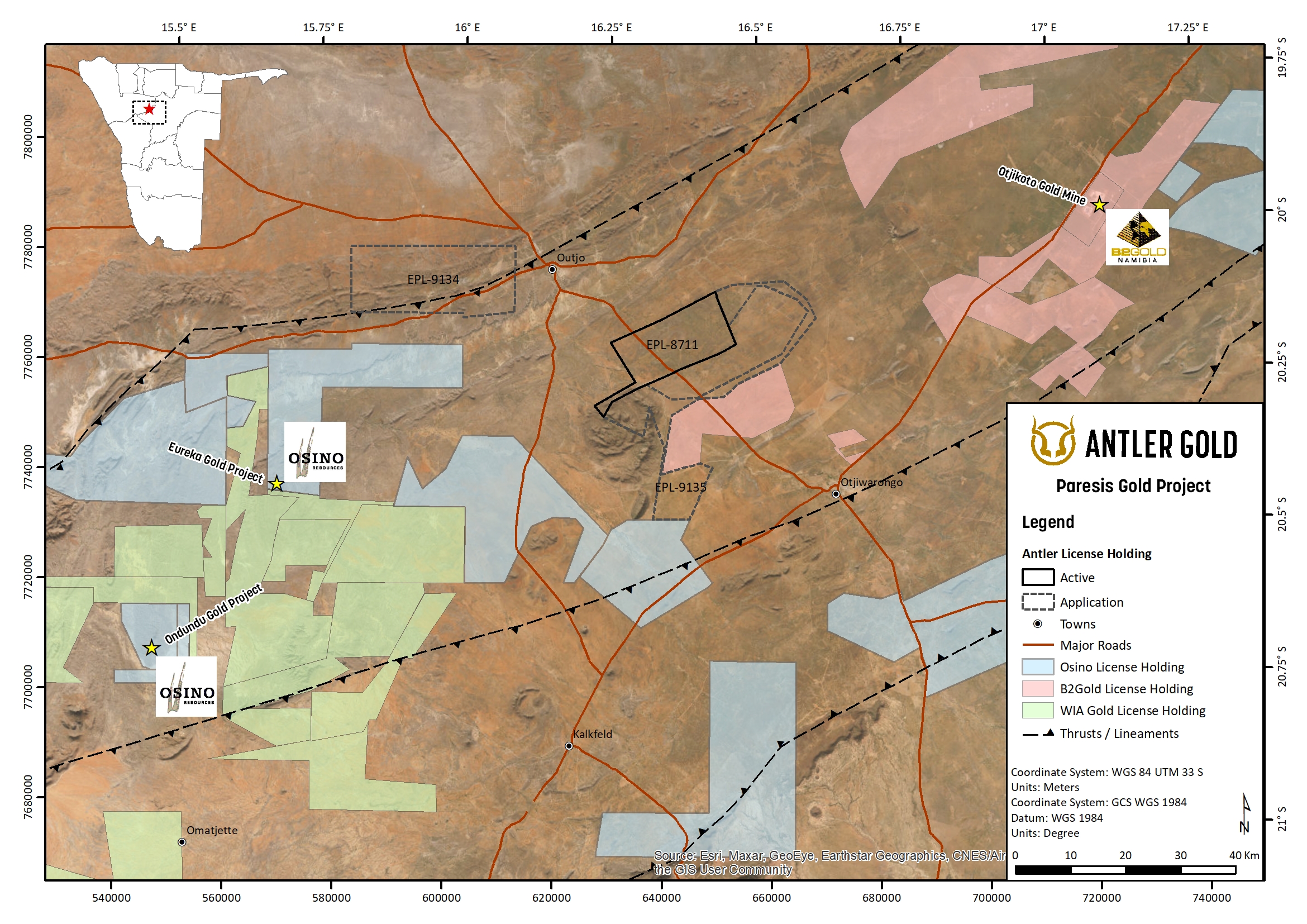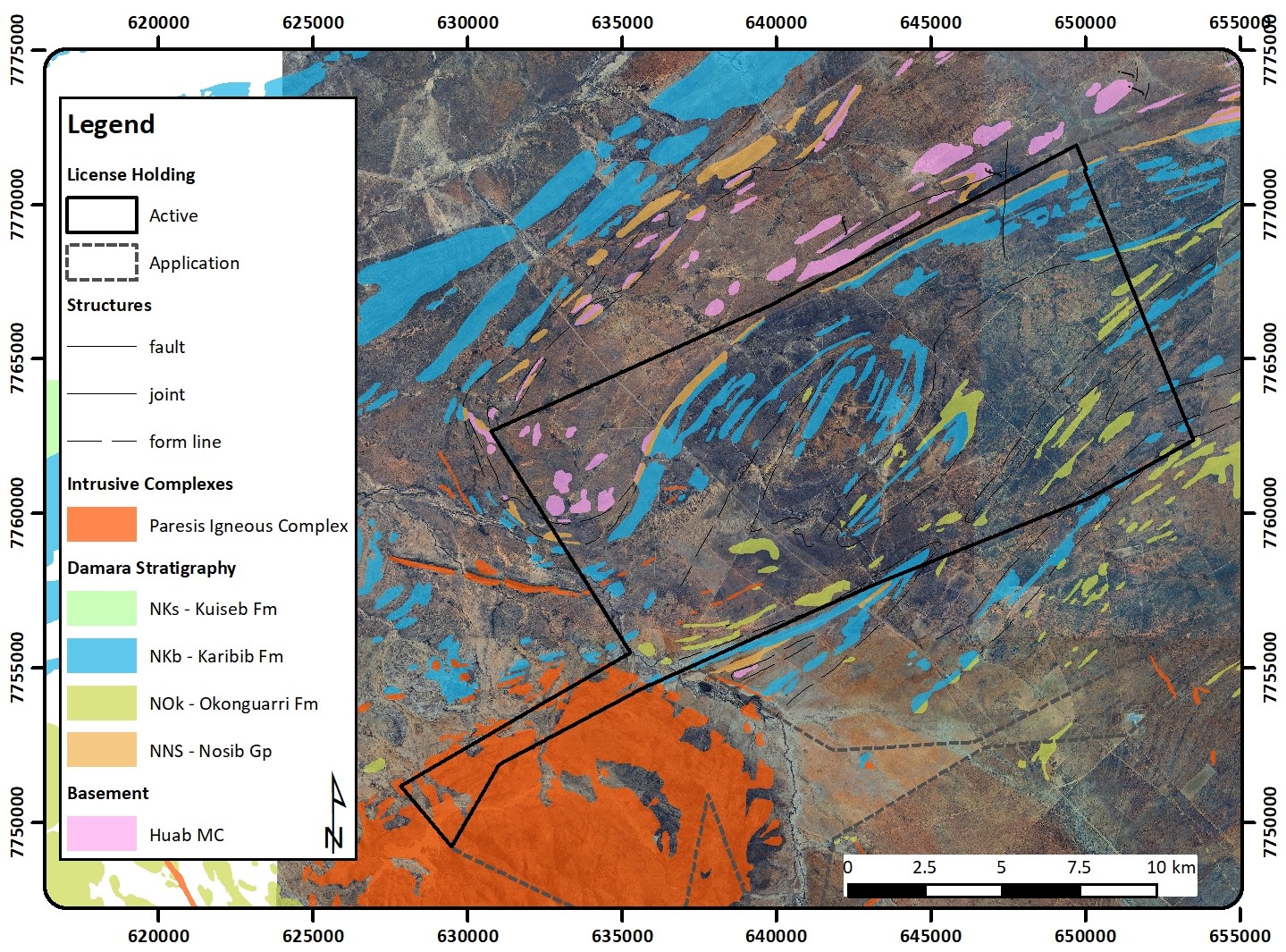Antler Gold Commences Gold Exploration Program at Paresis Gold Project in Namibia
February 5, 2024Halifax, Nova Scotia – (Newsfile Corp. - February 5, 2024) – Antler Gold Inc. (“Antler” or “Company”) (TSX-V:ANTL) is pleased to announce the commencement of exploration work at the Paresis Gold Project in north central Namibia.
Highlights
- The Paresis Project area covers approximately 21,000 ha within the highly prospective “gold corridor” of Namibia that hosts the Otjikoto Gold Mine (B2Gold) and the Ondundu and Eureka Gold Projects (Osino Resources).
- A conceptual project in an area with a complex deformation and magmatic history provides structural complexity and lithological variations, presenting potential for both intrusion-related and orogenic-style gold deposits.
- Prioritized Target Areas: Review of historical data (geochemical and airborne geophysical surveys), regional government data, and satellite imagery has allowed for the identification and prioritization of lithological and structural target areas.
“I am excited to share an update on our exploration efforts at the Paresis Gold Project, a key initiative in Namibia's renowned 'gold corridor'. In line with Antler’s core strategy, the Company intends on finding a suitable partner to progress the project through an earn-in or similar agreement, aimed at maximizing future discovery benefits for our shareholders. I am grateful for our team's dedication and I look forward to sharing additional progress in the near future,” said Christopher Drysdale, CEO of Antler Gold Inc.
Exploration Strategy
The exploration program will roll out in phases, starting with geological mapping and grab rock chip sampling as phase one, followed by a geochemical sampling program in the second phase, depending on initial rock chip assay results. Prospective lithological units of the Okonguarri and Karibib Formations (both Swakop Group) underlie the license area, however, the majority of the area is covered by soil and calcrete.
The Okonguarri Formation is the hosting stratigraphic unit at the Otjikoto Gold Mine (B2Gold) and at the Eureka Gold Project (Osino Resources), while the Karibib Formation is host to gold mineralization at various gold occurrences (Onguati, Goldkuppe, Erindi) in the Central Zone of the Damara Belt, including the Navachab Gold Mine (QKR) (along with the Arandis Formation) (Figures 1, 2 and 3).

Figure 1: Antler’s Paresis Gold Project license EPL 8711 relative to in-country peers B2Gold Namibia (pink), Osino Resources Namibia (blue), and WIA Gold (green).
The Paresis Gold Project
The Paresis Gold Project is currently made up of Exclusive Prospecting License (“EPL”) 8711 of approx. 21,000 hectares and another EPL application situated between the towns of Otjiwarongo and Outjo, ~290 km from the capital Windhoek, in north central Namibia, within the Northern Zone (NZ) of the Damara Orogenic Belt. The NZ is host to numerous mineral deposits, including the Otjikoto Gold Mine (B2Gold), the Ondundu and Eureka Gold Projects (Osino Resources), the Okanjande Graphite deposit (Northern Graphite) and the Okorusu Fluospar Mine to name a few, evidencing this geological environment’s fertile nature (Figures 1 and 2).
Outcrop on the license area is moderately to well-exposed, comprising rocks from the pre-Damara Basement, Nosib Group and Swakop Group (lower Damara Supergroup) (Figure 3, Table 1). The pre-Damara Basement has been tightly folded into km-scale upright folds striking roughly east-west. The Damara sequence has been intruded by younger Karoo-aged dolerite dykes and the Jurassic to Cretaceous-aged Paresis Igneous Complex (PIC).

Figure 2: Overview map of the Paresis Gold Project license EPL 8711 relative to other mineral deposits in north central Namibia. Relevant geological units (250K Geology Source: Geological Survey of Namibia) overlain on ESRI Earth natural colour satellite imagery.
Table 1: NZ stratigraphy of the Paresis tenement.

The Okonguarri Formation comprises a rhythmically interbedded sequence of limestone and meta-pelitic sediments (greywackes, schists, shales). This interbedded sequence of compositionally varying rocks introduces rheological contrasts (the way different rocks react to deformation) between lithologies or along lithological contacts which present favourable sites for potential mineralization (Figures 2 and 3).
The post-tectonic intrusion of the PIC rupturing through the Damara Supergroup that has already undergone multiple deformation and metamorphic events provides lithological variation and structural complexity, defining characteristics of gold deposits seen in Namibia. The PIC appears to be situated at a zone of structural discontinuity indicated by the different regional fabric orientations of the Damaran stratigraphic units surrounding the complex as postulated by Siedner (1965)1.
For more background information on the project, refer to News Release dated September 14, 2023.

Figure 3: Close-up of EPL 8711 with geological units over satellite imagery. Areas with no colour overlying the satellite imagery are covered by soil and/or calcrete. Coordinate System: WGS 84 UTM Zone 33 South; Units: Meters
About Antler Gold Inc.
Antler Gold Inc. is a Canadian listed mineral exploration company focused on organic royalty creation in Africa’s Top-Ranked Jurisdictions. The Company continues to assess new regional opportunities with the aim of building a risk diversified business model that allows the Company to generate short and long-term income whilst providing stakeholders with exposure to potential multiple returns that are generated from the discovery process.
Qualified Person
The technical and scientific information in this presentation has been reviewed and approved by Oliver Tors, B.Sc (Hons)., Exploration Manager of the Company, who is a registered Professional Natural Scientist (Pr.Sci.Nat. No. 120660) with the South African Council for Natural Scientific Professions (SACNASP) and a Qualified Person as defined by NI 43-101. Mr. Tors is an employee of Antler Gold Inc. and is not independent of the Company under NI 43-101.
Cautionary Statements
This press release may contain forward-looking information. This information is based on current expectations and assumptions (including assumptions relating to general economic and market conditions) that are subject to significant risks and uncertainties that are difficult to predict. Actual results may differ materially from results suggested in any forward-looking information. Antler Gold does not assume any obligation to update forward-looking information in this release, or to update the reasons why actual results could differ from those reflected in the forward-looking information unless and until required by securities laws applicable to Antler Gold. Additional information identifying risks and uncertainties is contained in the filings made by Antler Gold with Canadian securities regulators, which filings are available at www.sedarplus.com.
Neither TSX Venture Exchange nor its Regulation Services Provider (as that term is defined in policies of the TSX Venture Exchange) accepts responsibility for the adequacy or accuracy of this release.
For further information, please contact Christopher Drysdale, CEO of Antler Gold Inc., at +264 81 220 2439
1
Siedner, G., 1965. Structure and Evolution of the Paresis Igneous Complex, South West Africa. Transactions of the Geological Society of South Africa, pp. 177-206.
To view the source version of this press release, please visit: https://www.newsfilecorp.com/release/196488/Antler-Gold-Commences-Gold-Exploration-Program-at-Paresis-Gold-Project-in-Namibia
